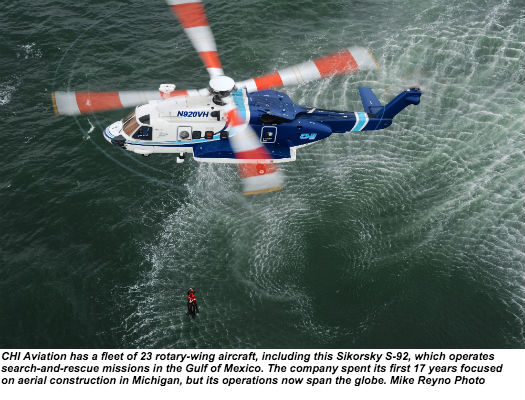
Down an unassuming dirt road leading to Livingston County Airport in rural Michigan, outside the small city of Howell, sits what appears to be — at least
on first glance — an equally unassuming hangar. But get a little closer, and there are clues to be found —the manicured lawns that surround the facility, the pristine parking lot, the immaculately decorated interior with hallways that feature dimensionally exact runway markings — that this is home to no ordinary utility helicopter company. It is, in fact, the headquarters of CHI Aviation — the company that made headlines and grabbed wider industry attention last year when it took over VIH Cougar’s offshore contracts in the hugely competitive Gulf of Mexico, a market that’s not used to having to welcome new entrants. Formerly known as Construction Helicopters, it’s a company that has been more than happy to remain under the radar until its enormous growth made that no longer possible.
Founded in 1980 by Don Werner and Pete Moyer, for the first 17 years of its existence its operations were largely local, its fleet was small, and its focus was on its specialization —heavy-lift aerial construction (hence the company’s name). The next 17 years saw it notch operational milestones with increasing regularity, as it broadened its scope of operating certificates, aircraft, the sectors it serviced, and where it flew. Today, it provides aerial crane, firefighting, helicopter emergency medical services, search-and-rescue, logistics support and ad hoc passenger trans- port services from bases in Howell; Boise, Idaho; Sacramento, Calif.; Galliano, La.; Barrow, Alaska; and Jalalabad, Afghanistan.
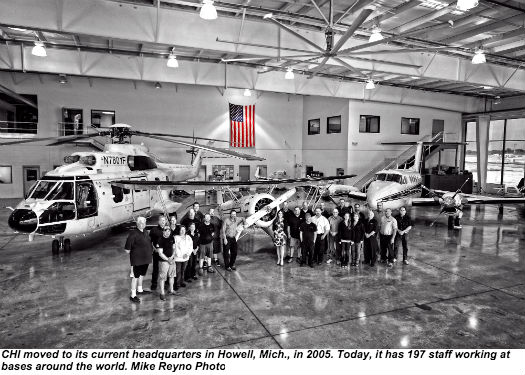
Vertical visited CHI’s Howell facility in June to get the story behind the headlines, and find out how it got to where it is today. As luck would have it, our arrival coincided with the very latest development at CHI — during a tour of the facility from company president and owner Chris Turner, he mentioned that the company was, in fact, closing on three new aircraft that day. Those aircraft happened to be Boeing CH-47D Chinooks, part of an initial batch of 15 being auctioned off by the U.S. Army for civilian use (see p.18). These new additions to CHI’s varied fleet, which also includes the Sikorsky S-61 and S-92, AgustaWestland AW139, Bell 205 and 212, and Airbus Helicopters AS332 L1 and AS350 B3e, brings the company’s total number of rotary-wing aircraft to 23. And, as its operations swell, so, too, do its staff numbers (the figure currently sits at 197).
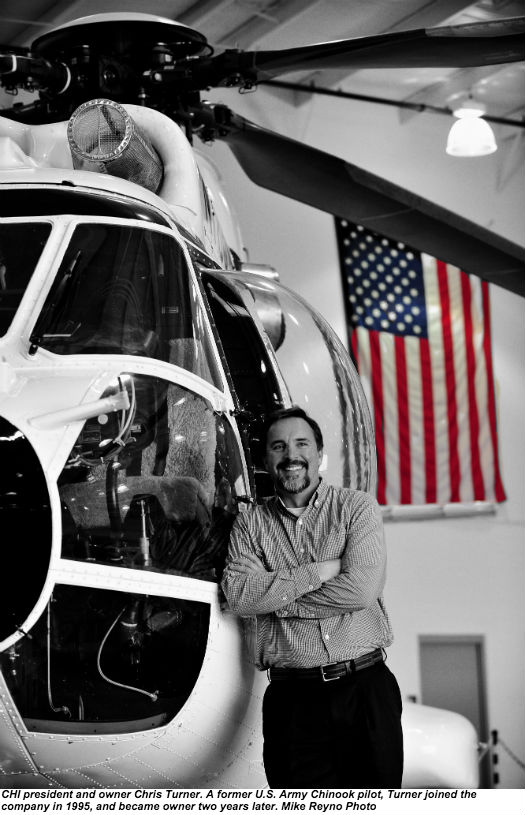
It’s no coincidence that CHI’s split history — becoming an ambitious and flourishing multi-sector operator after 17 years as a local heavy-lift construction company — coincides with Turner taking over at the company’s helm. When he arrived at the company as a pilot in 1995, there were just five employees and one aircraft — a Sikorsky S-58T. One of those employees was Jim Russell, who is still with the company today as general manager.
“We rarely travelled,” said Russell. “I remember the owners, when I first started, saying they didn’t see a need to go more than 200 miles away because we had that much automotive construction work right here: ‘It’s a helicopter, it shouldn’t have to travel that far.’ ”
Turner, a former Army Chinook pilot, met Werner while working at a competitor, and the two kept in touch as Turner’s civilian career progressed. When Werner began considering retirement, he reached out to Turner to gauge his interest in purchasing the company. After two years learning the company’s operations as a pilot, Turner bought the company in 1997.
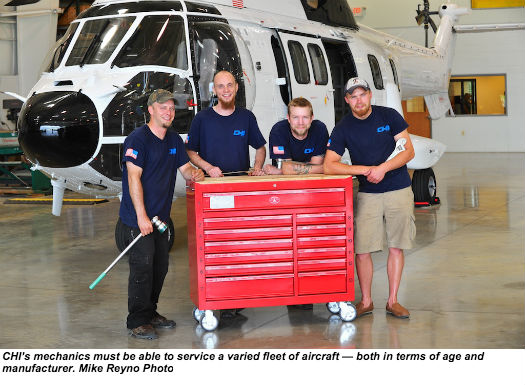
A Broadened Focus
The changes in the company were almost immediate. A second S-58T was added, with Mike Jones, a fellow Chinook pilot who knew Turner from the Pennsylvania Army National Guard, brought in as the company’s second pilot. Turner, Russell and Jones formed the backbone of the company as it developed over the next decade and half.
Recognizing that growth would be limited in servicing what was becoming a stagnant automotive industry in Michigan, Turner turned his attention and the company’s efforts into branching out into firefighting operations. CHI gained its Federal Aviation Regulations (FAR) Part 135 Certificate in 1998, and began firefighting work immediately in Texas and Florida.
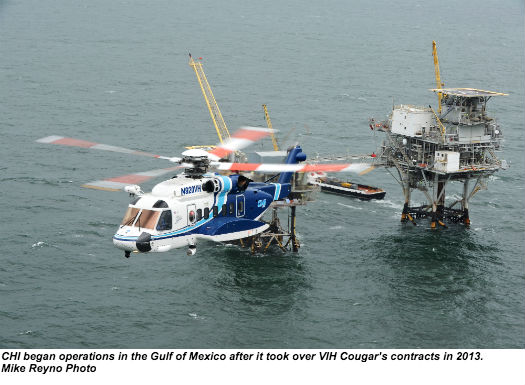
“We just kept growing from there,” said Turner. “We added our third S-58, got an exclusive use contract at Shasta-Trinity [National Forest] in 2000 . . . and in 2005 we brought on an S-61. That kind of elevated us to the next step.”
In 2008, CHI acquired Helimax Aviation in Sacramento, Calif., which it runs as a separate company with its own FAR Part 135, 137, 133, and 145 Certificates. Today, CHI’s firefighting operations are largely completed by its Helimax affiliate and its facility in Boise. The latter base, along with four aircraft and their associated U.S. Forest Service exclusive use firefighting contracts, were purchased from VIH Cougar in April 2012. Larry Kelly, the company’s director of fire operations, told Vertical that the Boise facility has the ability to share personnel and resources with Helimax for operational balance when needed.
The company generally uses the Bell 212 or 205 for firefighting operations, although the S-61 is also occasionally used. “I’m really excited about the CH-47s coming on and putting them on fires,” said Kelly. “They lift so much weight and will be a really great addition to the fleet. But we’ll also be using them for heavy construction lift work.”
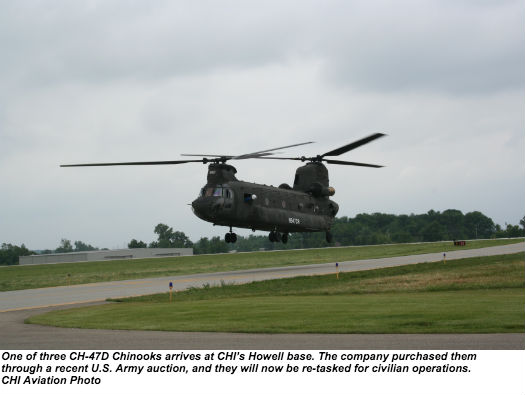
In the winter, Helimax has several frost patrol contracts it services in California, and some of the Boise-based aircraft are repositioned in Sacramento to cover that work. It’s also a time for heavy maintenance. “Some of my guys are checked out
on the Super Puma, so they’ll go out to Howell and do some construction work in the winter, too,” said Kelly. “Our pilots are pretty well rounded; they can do just about anything.”
In 2010, CHI once again moved into new territory, when it gained its Class D FAR Part 133 Certificate and 10 or More Part 135 Certificate, opening the door for it to apply for — and win — a Department of Defense (DoD) contract to provide logistics support in Afghanistan.
“I think we’ve always been proactive — [looking at] what’s the next step,” said Jones. “Things were slowing down, and Chris said, ‘Let’s look at getting everything we can get, op specs wise — [such as] Class D external loads and night vision goggles — let’s look at the DoD stuff and have our ducks in a row if we can get it. So we got a lot of things that we really didn’t need yet.”

With the contract in hand, CHI began operations in Afghanistan in December 2011, performing heavy-lift vertical reference work as well as internal cargo and passenger hauling. Since then, with just two aircraft (S-61s) operating at any one time, the company has hauled over 7 million pounds of cargo and over 100,000 passengers in the country. Its current contract runs through Oct. 31 this year, with a further option year available.
“The opening up of the DoD, because it’s an exclusive club to get in . . . it kind of changed everything for us,” said Turner. And the ability to meet the DoD’s exacting operational standards proved more than handy when the opportunity came to expand CHI’s operations into the Gulf of Mexico.
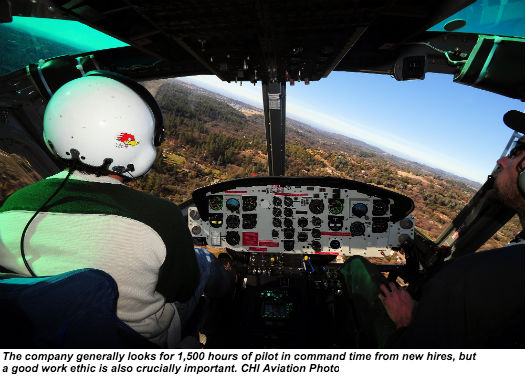
Moving Offshore
CHI’s entry into offshore operations in the Gulf of Mexico was far from straightforward, requiring the company to get involved in an issue that had quickly become “a very political football,” according to Turner. The issue was ownership control.
The U.S. Department of Transportation found that VIH Cougar — whose offshore contracts CHI would later assume — was under what it believed to be the control of a non-U.S. citizen. More specifically, under the control of VIH Aviation Group owner and CEO Ken Norie (a Canadian). VIH Aviation Group contested the finding, but nevertheless, in 2012, Norie approached Turner to see if he was interested in becoming the majority shareholder in VIH Cougar.
“At that time, we thought my coming in would just clear up the VIH Cougar problem, and that would be it,” said Turner. “But it didn’t, so that’s why we made the transition of moving the operations over to CHI and just shutting VIH Cougar down.”
The switch of the contracts from VIH Cougar to CHI took place in early 2013.

“Obviously we’re the little David amongst the Goliaths down there,” said Turner. “But the oil companies seem to like that. We do well on our audits, because we’re able to fix a problem right then and there — it’s not a large corporation.”
The operation, based in Galliano, revolves around the 24/7 offshore search- and-rescue (SAR) service the company provides with its S-92s and AW139, in partnership with emergency medical service provider Acadian Air Med. (You can read the full story on CHI Aviation’s SAR capabilities in the upcoming AMTC issue of Vertical 911.) CHI also completes ad-hoc passenger transports for oil companies in the Gulf, and recently won an offshore transportation contract from Shell in Brunei.
In terms of offshore growth opportunities, Turner said SAR work in the Gulf was likely already at capacity, but that he hoped to use the company’s experience in the segment elsewhere in the world. “The oil companies are putting that requirement on every place they work to have SAR, so we’re hoping to take it to other places, and we’ve had quite a few enquiries to do that,” he said.
At this year’s Heli-Expo, CHI signed up for an option on two Airbus Helicopters EC175s, which are due to be delivered in 2017. Turner said the current intent is to use them as SAR aircraft, but they’ll be assigned to whatever mission makes most sense at the time.
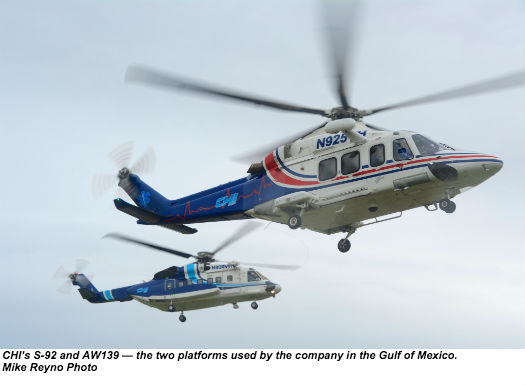
Picking the Right People
However, while diversification has enabled the company to grow to the extent that it has, and opened up new markets and opportunities, it also presents a challenge. At the organizational level, it’s clearly more difficult to keep on top of operations across a wide variety of sectors on a global scale, than one based around just the one industry and location.
For this reason, Turner said it was crucially important to select the right leaders for each operational segment. “We have good people in the right places that think like the rest of the team,” he said. “Obviously from the outside, this looks like a
lot of growth, but these are segments we understand and we can do. . . . We have a good talent pool of people that we bring together, who each understand the segment they work in completely. Where we’re growing now is more on that admin side of it. Running a helicopter is not a hard operation; keeping up with the paperwork is probably a hard operation.”

Turner added that the company has been able to take advantage of synergies between the various sectors, bringing best practices from its heavily regulated offshore work to areas such as firefighting and general utility operations.
To help ensure the company’s quality is maintained across the various segments, Mike Jones, the first pilot Turner hired back in 1997, now serves as CHI’s director of training and standards. “Because we’ve got so many different aircraft, pilots, and missions, we’re trying to standardize things,” he said. “Probably the biggest challenge is tracking the training, making sure everyone is current on their aircraft. No-one’s ever slipped through the cracks, but as we get bigger, we want to ensure that continues.”
In terms of new hires, Jones said they would be brought in for a specific mission, and the requirements would depend on what that mission was. “For instance, Afghanistan: I’m looking for long line, S-61 type rating guys with Afghanistan experience,” he said. “Sometimes you can’t get all three, so you’ve got to juggle — is it easier for me to make a long line guy an S-61 pilot? Or an S-61 guy a long line guy? We’ve tried both different routes. Some guys work out, some guys don’t.

“We’ve left the hour requirement pretty slim, because if we like the guy and he’s got a good work ethic,
we don’t want to not be able to hire him because he doesn’t meet the hours. But normally what we look at is Forest Service and DoD standards, which are pretty much parallel with each other: 1,500 hours of PIC [pilot in command] time.”
Fleet Support
Supporting airframes that run such a broad spectrum of age and manufacturer is clearly no small feat. “You have to stay on top of it,” said Steve Janos, CHI’s quality assurance manager. “We’ve actually had to put manuals together, customer-specific standard operating procedures, so we can ensure that we are satisfying all of our customers and complying with all of the contract requirements and customer needs.”
There are about 75 staff dedicated to maintaining the aircraft across the operational divisions, providing CHI with the capability to perform full airframe maintenance (component overhaul is completed through approved vendors).
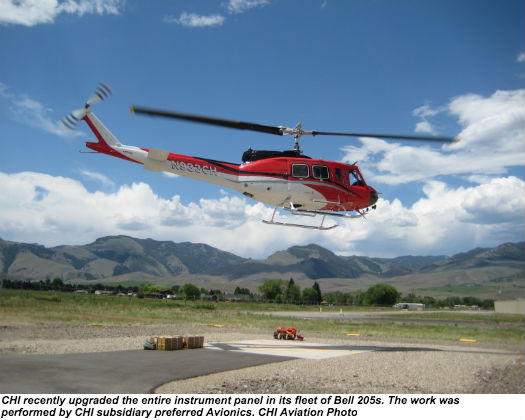
The company’s Galliano and Afghanistan operations have dedicated maintenance teams specific to the aircraft operating from those bases as part of their contracts, but the maintenance crews working across the rest of the company’s operations are tasked with working on a wide variety of airframes.
“The new airframes are all on power by the hour contracts, and it can be challenging to get the support that we want out of them,” said Turner. “The legacy airframes are more labor intensive because we’ve got to track the parts down, but sometimes we’re able to react faster on that then dealing with the OEMs [original equipment manufacturers] to get a part, because the parts are out there and we can find them.”

As part of the company’s desire to complete as much work in-house as possible, it established a subsidiary — Preferred Avionics — in 2000. Preferred Avionics works on CHI’s own aircraft, but also has the capability to complete installs in aircraft up to light jets. “We’ll move our avionics shop to wherever it needs to go,” said Turner. “Last year, we brought the 205s back here [to Howell], because we did a complete replacement of the instrument panels. It was easier to do that here. But normally we do it right in the field, and these guys go with it.”
Continuous Development
Looking ahead, the company is clearly excited about the arrival
of the Chinooks, and had already begun the hiring process for the additional pilots and maintenance staff required to operate the aircraft at the time of Vertical’s visit.
“When the government started auctioning them off, it was a perfect fit for us; heavy helicopters are what we do,” said Turner. The first Chinook was scheduled to begin firefighting operations later this summer; the other two aircraft may be used for global aerial construction work in non-congested areas ahead of next year’s fire season.
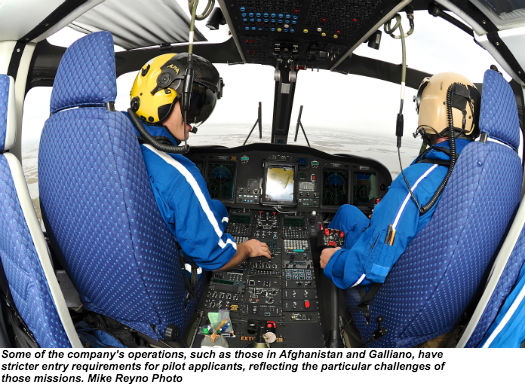
Turner also has high expectations for the utility of the Super Puma in the future heavy-lift world. “It’s a good utility aircraft, and I think it’s going to be the aircraft that’s going to transition the S-61 out,” he said. “I think you’re going to see the Puma take that role in the world.”
In terms of operational expansion, Turner said growth would be within the company’s existing segments of operation. Geographically, while the company is now spread throughout the world, South America holds relatively untapped potential for CHI. “It’s the oil-and- gas sector that’ll take us there,” said Turner. “We also think opportunities in Africa are going to expand with the DoD.”
However, while the oil-and-gas sector and DoD contracts provide great prospects, the strict operational requirements required to work in each sector can complicate CHI’s work in other segments — particularly when operating in remote areas.
“The oil companies require you have to have a work-stand when you work on the aircraft — but you might be in the middle of the forest,” said Turner. “When we went to Barrow, we didn’t have workstands. We had to ship them up, and they didn’t arrive the same time the aircraft did. It was like an Act of Congress to get it approved so that we could actually go up and preflight the aircraft.”

Because of this, the company is planning to switch its utility operations to be under its Helimax subsidiary. “We’ll still have the same quality, we just won’t have the same auditing requirements, and it’ll make our customers happier,” said Turner.
And keeping the customer happy is a key focus — and the reason this company, despite operating almost in stealth mode, has not only continued to grow, but prosper. “Like I tell everyone here, I can write all the checks in the world, but the customer puts the money in the account so that your check’s good,” said Turner. “We have some pretty demanding customers, but it’s my standard we maintain. We exceed the customer’s standards.”
While CHI can no longer remain under the radar, as a marker of success, that’s no bad thing. And the future certainly looks bright for this company, which has uniquely established a foothold in such a diverse range of sectors. For those that have been at the company throughout its extraordinary development, it’s been
an interesting journey. “I’ve always looked at it like I’m curious to see what’s around the next corner,” said Mike Jones, the company’s director of training and standards. “Every single year, something’s different — different aircraft, different missions. The thing that keeps me going is just the curiosity
of what’s next.”





